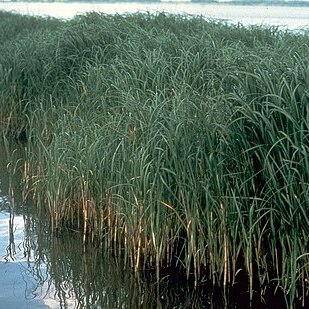Culms coarse, soft and fleshy, to 3 m, or in the north as low as 3 dm, sulfurously malodorous when bruised, rhizomes elongate, thick and soft, the closely imbricate scales inflated; lvs elongate, 5–15 mm wide, glabrous or nearly so; panicle narrow, 1–3 dm; spikes slender, appressed to the axis, 5–10 cm; spikelets scarcely imbricate, erect or nearly so, those on one side of the spike usually 3–8 mm apart; rachis prolonged beyond the uppermost spikelet and usually conspicuously exceeding it; spikelets glabrous or somewhat hairy; first glume linear, half to nearly as long as the lemma; second glume 10–14 mm, exceeding the lemma, its midvein scarcely or not at all prolonged beyond the thin margins; 2n=42, 56, 70. Coastal salt-marshes, mainly intertidal, smaller at the upper tidal margins; Que. and Nf. to Fla. and Tex.; also on the Atlantic coast of S. Amer. and in n. Europe.
Perennial with soft fleshy rhizomes. Culms stout, forming large clumps, erect, (0.5–)1–2(–3) m tall, ca. 1 cm in diam. Leaf sheaths mostly longer than internodes, smooth; leaf blades linear-lanceolate, flat, 10–90 × 1–2 cm, smooth or margins minutely scabrous, tapering to long hard involute apex; ligule ca. 1 mm. Racemes racemosely arranged, (5–)10–20, 5–20 cm, slender, erect or slightly spreading; spikelets scarcely overlapping; rachis smooth, terminating in a bristle up to 3 cm. Spikelets ca. 10 mm, glabrous or nearly so; lower glume linear, 1/2–2/3 as long as spikelet, acute; upper glume ovate-lanceolate, as long as spikelet, glabrous or with very short hairs on keel, subacute; lemma lanceolate-oblong to narrowly ovate, glabrous; palea slightly longer than lemma. Anthers 5–6 mm. 2n = 62.


